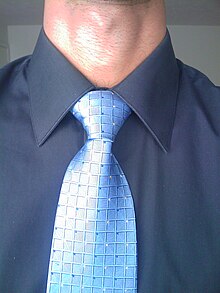Windsor knot
This article needs additional citations for verification. (February 2009) |
| Windsor knot | |
|---|---|
 | |
| Typical use | usually worn at meetings, interviews, and special occasions |
The Windsor knot, also referred to as a Full Windsor or as a Double Windsor to distinguish it from the half-Windsor, is a method of tying a necktie around one's neck and collar. The Windsor knot, compared to other methods, produces a wide symmetrical triangular knot. The knot is often thought to be named after the Duke of Windsor (King Edward VIII after his abdication). It was, however, likely invented by his father George V.[1] The Duke preferred a wide knot and had his ties specially made with thicker cloth in order to produce a wider knot when tied with the conventional four in hand knot. The Windsor knot was invented to emulate the Duke's wide knot with regular ties. The Windsor knot is worn on more formal occasions, and it is especially suited for a spread or cutaway collar that can properly accommodate a larger knot. For correct wear the tie used for a windsor knot should be about 40 cm longer than a conventional tie. The Windsor knot is the only tie knot that is to be used by all personnel in the Royal Air Force and the Royal Air Force Cadets (ATC and CCF(RAF)) in the UK when wearing their black tie while in uniform. The Windsor knot is the tie knot used by the Canadian Forces, regardless of service.
Description
When tied correctly the knot is tight and does not slip away from the collar during wear. It is very comfortable to wear, as the knot itself will hold the tie firmly in place while still keeping space between the collar and the neck.
The knot is symmetrical, well balanced, and self-releasing. It is a large knot, which amply displays the fabric and design of the tie when wearing a closed jacket or coat, and helps keep the throat area warm during the colder winter months.
A large knot can distract attention away from the wearer's face; therefore, a Windsor best compliments a strong square or round face, or those sporting facial hair.
James Bond never trusted a man who boasted a Windsor Knot; "It was tied with a Windsor knot. Bond mistrusted anyone who tied his tie with a Windsor knot. It showed too much vanity. It was often the mark of a cad." -From Russia With Love
Tying

To tie the Windsor, place the tie around your neck and cross the broad end of the tie in front of the narrow end. Then fold the broad end behind the narrow end and push it up through the inside of the loop around your neck. The left and right sides of the narrow end, and the inside of the loop, now form a triangle. The third and fourth folds should complete one rotation around the outside of the knot. The fifth fold brings the broad end over the top of the knot from the front to the back. The sixth and seventh folds again complete one rotation around the knot. The eighth fold should again bring the broad end up over the top of the knot from behind; push the end down through the loop in front of the knot that you made with the seventh fold, work out any wrinkles, and pull the knot tight. If the tie is unbalanced, untie the knot and try again giving yourself more or less length to work with.
In The 85 Ways to Tie a Tie, by Thomas Fink and Yong Mao, the Windsor knot is listed as "knot 31" and tied, in that book's notation, as follows:
- Li Co Ri Lo Ci Ro Li Co T
Fink and Mao list the following as common variations on the Windsor:
- Li Co Li Ro Ci Lo Ri Co T (knot 32) (the "Persian Knot")
- Li Co Ri Lo Ci Lo Ri Co T (knot 33)
- Li Co Li Ro Ci Ro Li Co T (knot 35, shown as "the Windsor Knot" in the image immediately below).
Step by step guide to tying the Windsor knot
This is a guide for a "softer" knot (in Fink and Mao's notation Li Ro Li Ro Ci Ro Li Co T):
Step by step guide to tying an alternative Windsor knot
See also
- Half-Windsor knot – a narrower knot which references the name, as it only brings up around the loop on one side rather than both.
- List of knots
